Convection Oven 101
The oven is undoubtedly the shining star of the holiday meal. But when it comes to using a convection oven, what makes this method of preparing turkey preferable to other styles of cooking? Don’t let the unfamiliarity intimidate you! We’re breaking it down to help you make the most of your convection oven this Thanksgiving (or really any time of year).
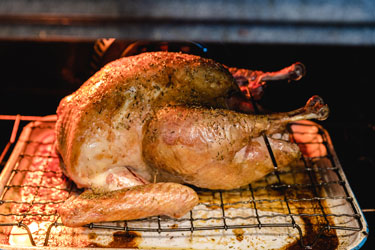
What is the difference in a convection oven versus a conventional oven?
A convection oven has a fan and exhaust system that circulates heat around the oven while the food is cooking and ventilates regularly to prevent humidity. A regular oven has a single heating unit, meaning the heat is inconsistent and only flows from one direction.
What are the benefits to using a convection oven?
Using a convection oven yields more efficient cooking. Because dry hot air is blowing directly on the food, your dishes will cook about 25 percent faster in a convection oven. Additionally, the circulating convection heat prevents oven “hot spots,” making the entire oven space perfect for cooking the turkey and side dishes all at once.
What temperature setting should I use when preparing a whole bird/holiday meal?
350°F
The preferred method is to roast the turkey in the center of the lowest rack or oven shelf so the top of the turkey will be centered in the oven. If two racks must be used, place the turkey on the lowest or middle rack. When cooking with two roasting pans, position the pans in opposite corners of the oven. Place the pans so one is not directly over the other.
How long do I cook a turkey in a convection oven?
Depending on the size of your turkey, follow the chart for convection cooking or until you’ve reached the proper temperature. Use a meat thermometer to test the temperature in the thickest part of the thigh but not touching the bone. If your turkey is stuffed, also verify the temperature of the stuffing has reached 165°F.
- 12-15 pounds, 1.5-2 hours
- 15-20 pounds, 2-2.5 hours
- 20-25 pounds, 2.5-3 hours
Other signs that the turkey is done are that the legs move loosely, and the juices run clear. Verify the internal temperature in several places – the thickest parts of the breast, thigh and wing – to be sure.
Depending on your brand of oven, it is recommended to reduce traditional turkey baking times from 10-40 percent.
Are there any tricks to ensuring my turkey stays tender and juicy in a convection oven?
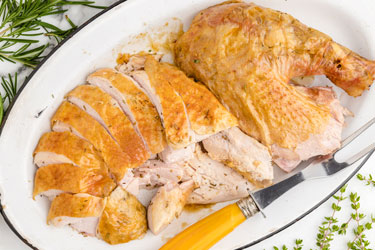
- Start with a fully thawed turkey. See USDA’s tips on safely thawing your turkey.
- There is no need to baste the turkey when using a convection oven because the blowing heat sears the turkey quickly, which locks in the juices. If a special sauce or marinade is used, baste the turkey during the last hour of cooking.
- There is also no need to cover the turkey with foil because you want the turkey to sear and reach a golden brown color. However, if the legs or wings start to get too brown, cover those areas with foil.
Traditional Roast Turkey in Convection Oven Recipe
Ingredients
- Fresh or frozen turkey – size is up to you depending on how many you’re feeding!
- ½ cup oil, olive or vegetable
- Rosemary, to taste
- Thyme, to taste
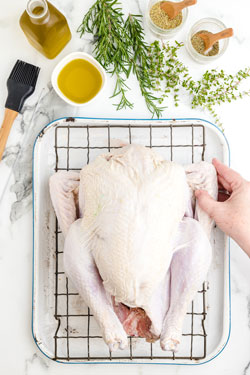
Instructions
1. Adjust oven rack to the lowest setting to make sure you have enough room for your turkey.
2. Preheat your convection oven to 350°F.
3. If your turkey has the neck and giblets, remove and keep for other uses if desired.
4. Use a low sided sheet pan with a rack. If using a higher sided roasting pan, make sure to use a rack that lifts the turkey up off of the bottom of the pan so the air can get around the whole turkey. With a convection oven you want the air to circulate around the turkey as much as possible. Place the turkey on the rack in the pan.
5. Do not truss or tie the turkey. This allows the warm heat of the convection oven to touch as many surfaces of the turkey as possible.
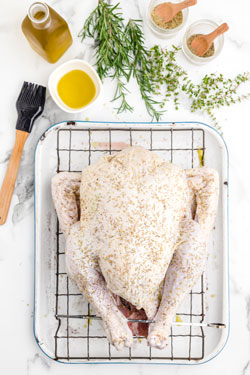
6. Tuck the wings under the turkey.
7. Loosen the skin at the edge of the breast.
8. Place some oil in a small dish and using a brush or your hands, brush oil all over the turkey and under the skin of the breast.
9. Sprinkle the turkey with rosemary and thyme.
10. Using a metal skewer, stick the skewer between the two legs to keep the turkey balanced on the rack.
11. Wash hands and sanitize surfaces thoroughly after handling raw meat.
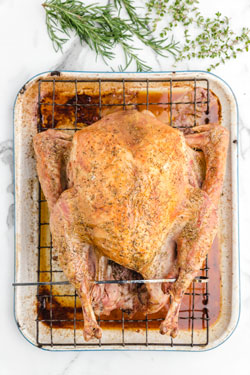
12. Place the turkey in the preheated oven and roast per the recommended time on the convection oven chart or until the meat thermometer reads 165°F.
Keep an eye on the turkey towards the end. If the wings and legs look like they are getting too brown, cover with foil.
13. Remove the turkey from the oven, tent it with foil and let it rest at least 20 minutes before carving to serve. It will continue cooking for just a bit after removing from the oven (called carryover cooking and makes the turkey juicier).
